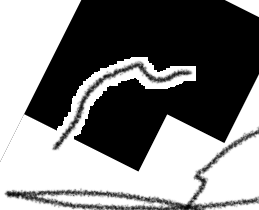Canvas
Surface Format and Rendering

 – incremental screen updates during a stroke
– incremental screen updates during a stroke
MyPaint stores its pixel data inside tiles of a fixed size. The TiledSurface class allocates memory just for the tiles that you paint on. When the screen is updated, the tiles are composited into a temporary rectangular pixbuf, which is then passed to Cairo for rotated and zoomed rendering.
During painting, all tiles touched by the stroke are composited completely, but the update region is clipped to the bounding box of the new dabs.
Pixel Format
MyPaint’s internal pixel storage uses tiled surfaces where each tile is a square pixel array of side N (currently 64), organized top-to-bottom and left-to-right. These memory areas are also the data segment of a NumPy array of dimensions (N, N, 4), and the data type uint16. Pixels are stored as RGBA data using an unusual but speedy “15+1”-bit floating point value where 0x8000 (1<<15) represents 1.0 and 0x0000 represents 0.0. Pixel R, G, and B values are stored multiplied by the pixel’s alpha component and are currently nonlinear with an assumed sRGB gamma curve.
New code should use the inline functions defined in fix15.hpp for clarity.
In some (but not all) rendering contexts we ignore the backdrop’s alpha for speed, and assume that it’s always 1.0. Historically, MyPaint has always rendered layers over a solid background, but as of the current development master, this is changing.